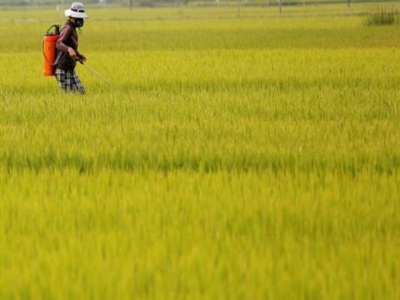Asia rice-Vietnam rates dip for 4th week as Chinese norms bite

A farmer works on a rice paddy field in Quang Ngai province, Vietnam March 14, 2018. Photo: Reuters
Rice export prices fell for the fourth consecutive week in Vietnam on concerns of lower intake from China due to stricter norms in Beijing, while subdued demand weighed on the Indian and Thai markets.
In Vietnam, the third biggest exporter of the staple, prices of the benchmark 5 percent broken variety fell to $395 a tonne from last week's $400 level.
"We are still concerned about China's move to impose stricter conditions on shipments from Vietnam as China is the largest export market," a trader based in Ho Chi Minh City said.
"This will have an adverse impact on Vietnam's rice exports for the coming years."
Vietnam's rice shipments to China fell 39.1 percent in the first 10 months of 2018 from a year earlier, according to the Ministry of Industry and Trade.
In Thailand, benchmark 5 percent broken rice prices were quoted at $385-$393, free on board Bangkok, versus $390-$393 last week on flat demand, traders said, adding the market was likely to remain quiet going into the new year period.
"There are talks that some of our neighbours like the Philippines still want more rice, but there are no indications at this stage whether there will be fresh deals," a Bangkok-based rice trader said.
A gradual increase in supply due to seasonal harvesting during the December and January period could further dampen prices, another trader said.
Meanwhile, rates for top exporter India's 5 percent broken parboiled variety were unchanged from the previous week at $364-$368 per tonne.
"We have slashed prices in the last few weeks after a subsidy was announced, but demand is still weak," said an exporter based at Kakinada in the southern state of Andhra Pradesh adding it was not possible to cut prices further, while local paddy prices are firm.
The Indian government will give a subsidy of 5 percent for non-basmati rice exports for the four months to March 25, 2019, the trade ministry said last month.
Meanwhile, neighbouring Bangladesh's rain-fed rice, or 'Aman' crop, is likely to rise to 14 million tonnes from 13.5 million tonnes the previous year, helped by favourable weather, Mohammad Mohsin, director general of Department of Agriculture Extension, told Reuters.
Aman, the second biggest crop after the summer variety Boro, makes up about 38 percent of Bangladesh's total production of around 35 million tonnes.
The south Asian country, which emerged as a major importer in 2017 after floods damaged its crops, imposed 28 percent duty to support its farmers after local production revived this year.
Related news
 Turmeric cultivation under value chain and organic fertilizer production from tumeric side
Turmeric cultivation under value chain and organic fertilizer production from tumeric side Applying the science and technology in building the model of turmeric cultivation under the value chain and producing organic fertilizer from turmeric side
 Farm exports face CPTPP challenges
Farm exports face CPTPP challenges Though the Comprehensive and Progressive Agreement for Trans-Pacific Partnership (CPTPP) will reduce many tariffs to zero in member countries
 The year 2018 in review: rice exports see strong growth in volume and value
The year 2018 in review: rice exports see strong growth in volume and value Vietnam's rice export volume is likely to reach around 6.15 million tonnes and be worth over US$3.15 billion in 2018, up 5.7% in volume and 19.6% in value over